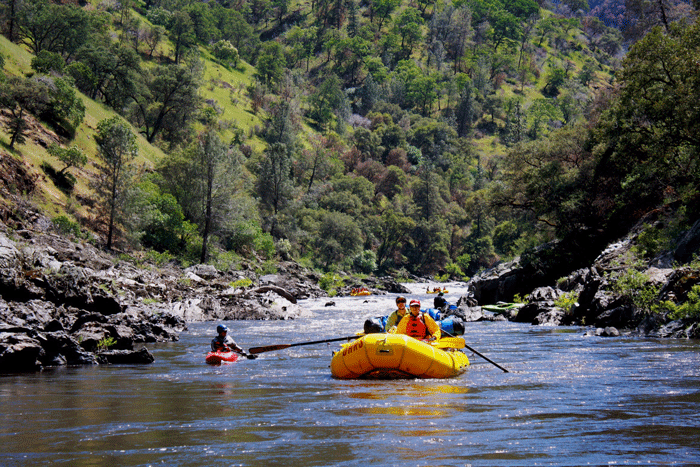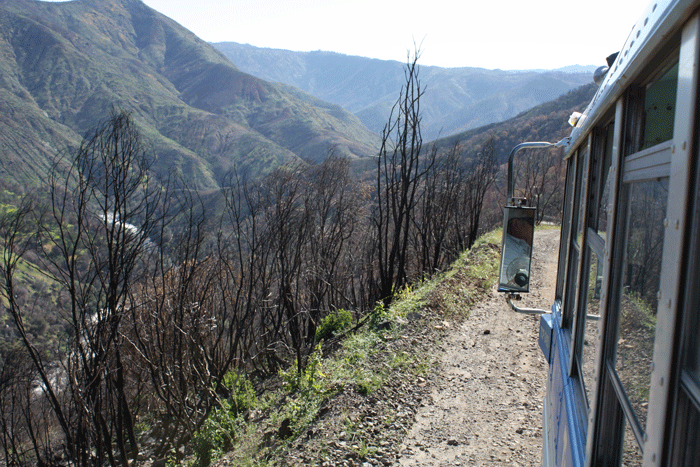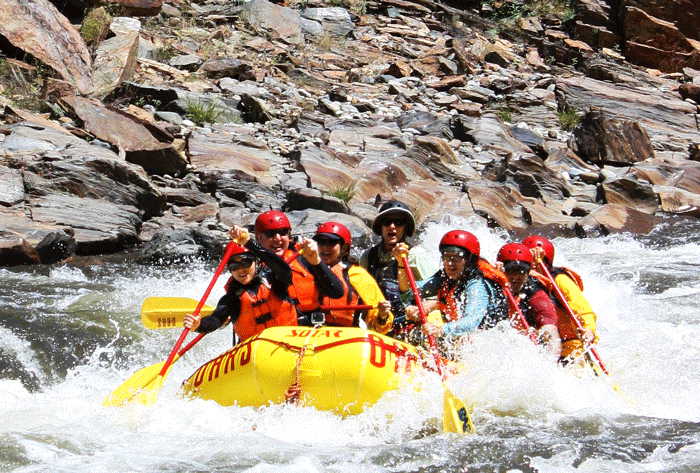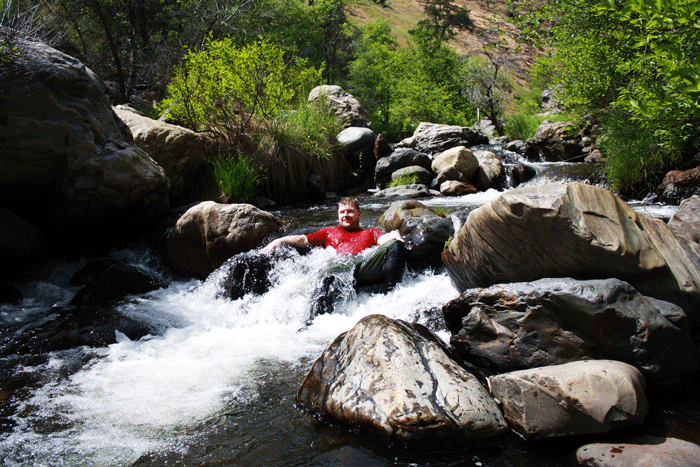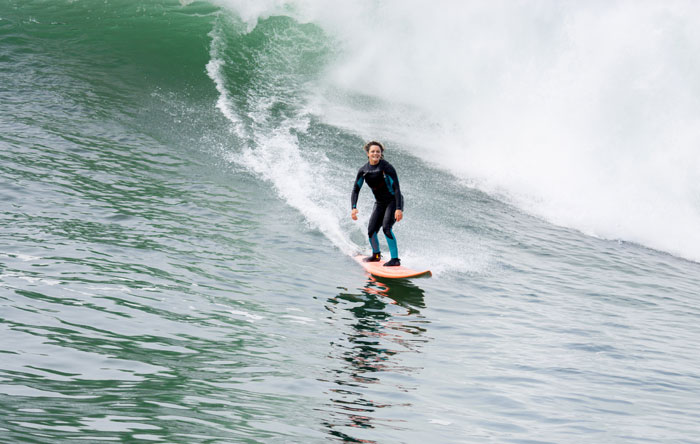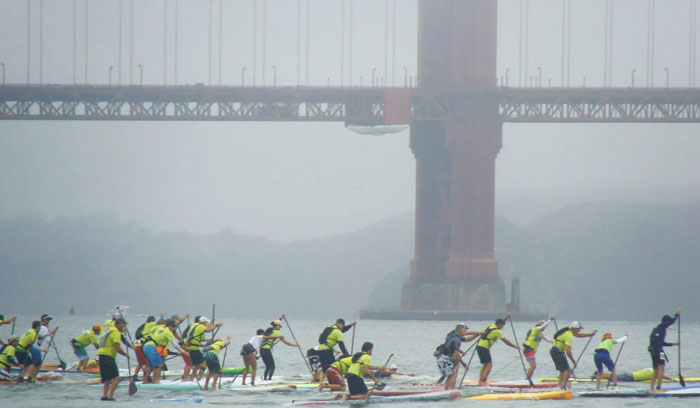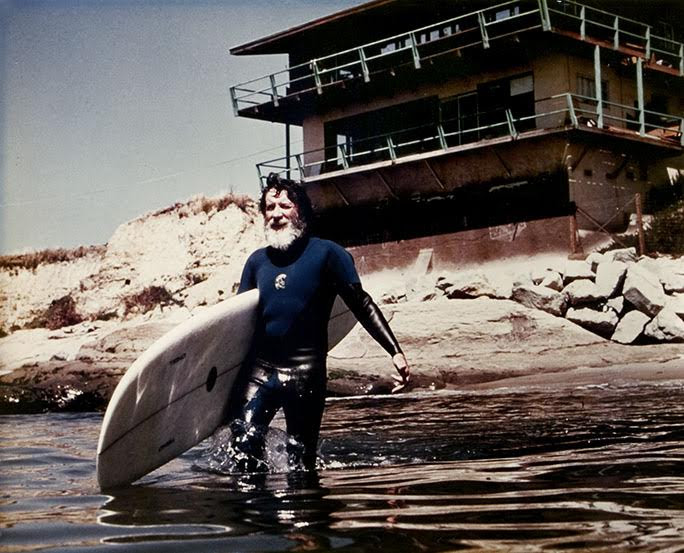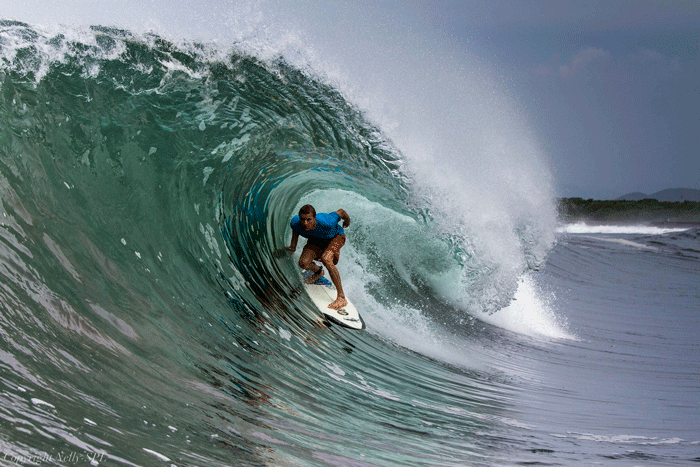- Tahoe’s Nevada Beach Tops the List of Hard-to-Book Campgrounds - 07/17/2024
- Cannabis Watershed Protection Program Cleans Up Illegal Grow Sites - 07/10/2024
- French Fire - 07/05/2024
After the largest fire in Sierra history sorched its banks, the Tuolumne remains an artery of life and thrills through the burn zone
By Pete Gauvin
At river level, regeneration happens quickly. Most of the time, you’re unlikely to even notice the charred hillsides stretching behind you as you focus on the churning whitewater ahead, your peripheral vision taking in the green riparian zone where healing happens first.
That’s not the case driving down the put-in road, the five-mile descent down Lumsden Road to Meral’s Pool, the start of this classic 18-mile run down the Wild & Scenic Tuolumne River, widely considered the best overnight raft trip in California – one that features reliable, fun and exciting flows even in critically dry years like this one.
Soon after you turn off Highway 120 east of Groveland and begin the bumpy descent into the canyon, you enter the devastation zone. Blackened trees stand like tombstones in a massive graveyard stretching up and down steep mountainsides to the north and east toward Yosemite National Park.
As the visual shock fades though, you begin to notice branches of green defiantly sprouting from the tops of many of the very same trees (oaks mostly), and poppies, lupine and Mariposa lilies, and elsewhere, poison oak, adding splotches of color to the blackened soil. Nature, ever encouraging, displaying its powers of resilience.
Remarkable because less than a year ago, “the T” or “Mother T” – as it’s called by river guides and other whitewater hounds that have a fond, enduring relationship with the Tuolumne – was at the epicenter of the largest wildfire on record in the Sierra Nevada.
The Rim Fire, started on Aug. 17 by a hunter’s illegal camp fire, raged for three weeks before it was contained, scorching more than 257,000 acres of the Stanislaus National Forest and remote portions of Yosemite.
Of course, it abruptly put an end to the rafting season on the Tuolumne, which is dam-controlled with boaters relying on well-timed releases from the Hetch Hetchy system, usually through September. That, followed by the two-week government shutdown that closed Yosemite in October, dealt a huge economic blow to the area.
In May, with signs of spring still evident despite summer-like temperatures, I was fortunate to join OARS rafting company for its first commercial river trip down the Tuolumne this season, the first since the fire.
“We feel a sense of responsibility to the local communities to help bring tourism back to the Toulumne, hit by the double whammy of fire and the government shutdown,” said Steve Markle of OARS, based in nearby Angels Camp. “There are large burn areas but the fire didn’t by any means destroy the canyon. And it certainly didn’t change the quality of the rapids.”
Joining the flotilla of five rafts, two paddle rafts and three gear boats (“going light” is not the credo of these trips), were several journalists from around the state; river advocate and naturalist Peter Drekmeier of the Tuolumne River Trust; and George Wendt, the gracious, good-natured founder of OARS, a pioneer in the adventure travel industry for 45 years, along with a crew of colorful and competent guides, including his sons, Tyler and Clavey.
Lead guides Chris Moore (paddle rafts) and Ely Helvey (gear boats), with hundreds of trips down the T between them, led the way. You could tell in their eyes, the trip wasn’t diminished at all. There was perhaps a little extra sediment load in the water, they said, after we bumped down the first significant rapid, Rock Garden, but the upside of our record light winter is that it greatly minimized erosion.
And the rapids, more than a dozen rated Class IV or higher – Sunderland’s Chute, Ram’s Head, Clavey Falls, Gray’s Grindstone, Hell’s Kitchen, among them – along with numerous Class III rapids to keep the action going and the boats rolling, remain unchanged – with the added bonus of several additional rapids, including Class IV Pinball, in the last couple miles. Normally, they would be under the waters of Don Pedro Reservoir, but with the drought, the reservoir is experiencing a severe case of shrinkage.
That’s right, for all the lamenting boaters have made over the drought, here’s a benefit: No flat water paddling all the way to the takeout at Ward’s Ferry Bridge. Current when you need it most.
During a camp-chair seminar over cold beers while the guides prepped a decadent dinner at our beachhead for the night, Drekmeier gave us a detailed history of the Tuolumne, from the damming of Hetch Hetchy Valley in 1923 to its designation as Wild & Scenic in 1984, and the decades long battles over its water. The river provides water for 2.6 million people in the Bay Area, feeds farms in the Central Valley through the Turlock and Modesto irrigation districts, and still manages to send a fraction down its entire 149-mile length for fish and wildlife.
The Rim Fire burned over 400 square miles, an area eight times the size of San Francisco, almost all of it (97 percent) within the Tuolumne River watershed. While it scorched some areas into a moonscape, Drekmeier said the amount of recovery we witnessed suggested that the fire did not burn as hot through the canyon.
So if you’re hesitant about visiting Mama T this summer, don’t be. While the Rim Fire gave her a slight makeover, other than distant views of charred mountainsides and a few spots where flames licked the banks, once in the canyon you’re unlikely to feel like you’re floating through a devastation zone. And the rapids on this California classic are as good as ever. If you’re rafting experience is limited to the South Fork American River, the Tuolumne is an exciting step up.
Finish your trip with a pitcher of beer and a burger with your raft mates at the Iron Door Saloon in Groveland, the oldest continuously operated bar in California, and you’ll help the local economy with its recovery, too.
——————————————————————————————————————————–
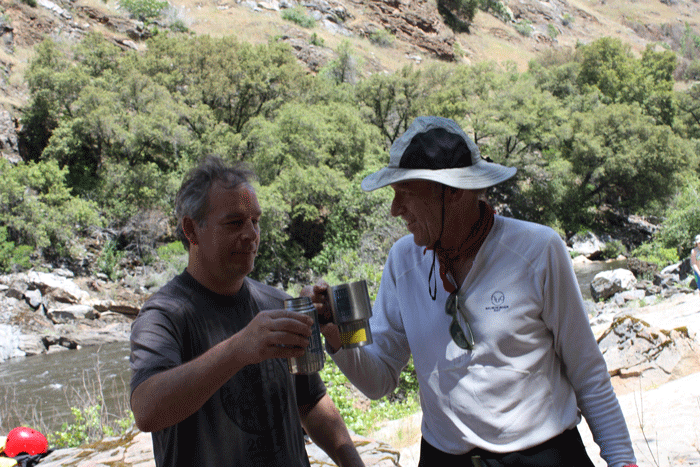
Peter Drekmeier of the Tuolumne River Trust, left, and OARS founder George Wendt toast the return of Mama T post Rim Fire (Pete Gauvin).
GUIDED TRIPS
OARS offers one, two and three-day trips on the Tuolumne River through August. The multi-day trips offer time to explore and camp in the canyon. Side hikes can be made to swimming holes above the confluences of the Clavey River and North Fork Tuolumne. Other outfitters also specializing on trips on the Tuolumne include:
• ARTA River Trips arta.org, 800.323.2782
• All-Outdoors Whitewater Rafting aorafting.com, 800.247.2387
• O.A.R.S. oars.com, 800.446.7238
• Sierra Mac River Rafting sierramac.com, 800.457.2580
Sierra Mac and ARTA are both based in Groveland.
PRIVATE TRIPS
The Tuolumne is a permitted river, which helps maintain its solitude. The U.S. Forest Service permits are free and must be picked up at the Groveland Ranger Station (209.962.7825), nine miles east of Groveland on Highway 120.
RIM FIRE RECOVERY
For more information on the Tuolumne River Trust’s “Heal the Burn” recovery campaign, and what you can do to help by volunteering your time or making a donation, visit tuoloumne.org. A short video documents the area before and after the fire.

